Analyzing RAV4's Marketing Management Strategies: A Case Study
VerifiedAdded on 2023/06/11
|6
|1216
|401
Case Study
AI Summary
This case study examines the marketing management strategies of RAV4 in the Australian market, focusing on macro-environmental forces, product lifecycle, market segmentation, and consumer decision-making processes. It identifies key challenges such as increasing competition from subcompact SUVs and the need to appeal to a younger demographic while retaining loyal older customers. The analysis covers the maturity stage of RAV4's product lifecycle, recommending updates to the brand to reclaim youth appeal and emphasizing a comprehensive marketing mix involving product, place, price, and promotion. The study also explores the importance of target marketing and how to effectively communicate with both existing and potential customers. The consumer decision-making process is analyzed, with recommendations for Toyota to address customer needs at each stage, ensuring satisfaction and loyalty. Desklib provides access to similar case studies and solved assignments for students.
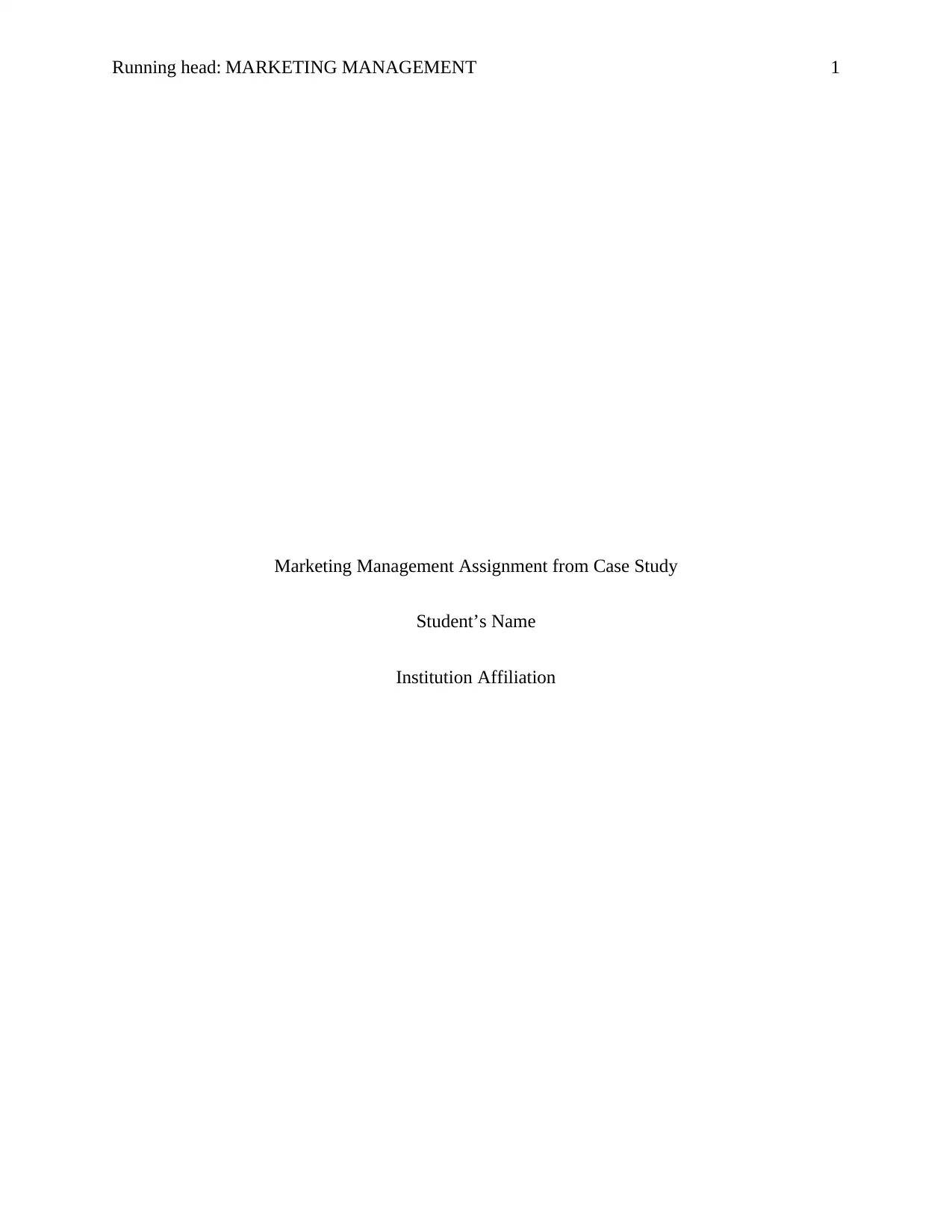
Running head: MARKETING MANAGEMENT 1
Marketing Management Assignment from Case Study
Student’s Name
Institution Affiliation
Marketing Management Assignment from Case Study
Student’s Name
Institution Affiliation
Paraphrase This Document
Need a fresh take? Get an instant paraphrase of this document with our AI Paraphraser
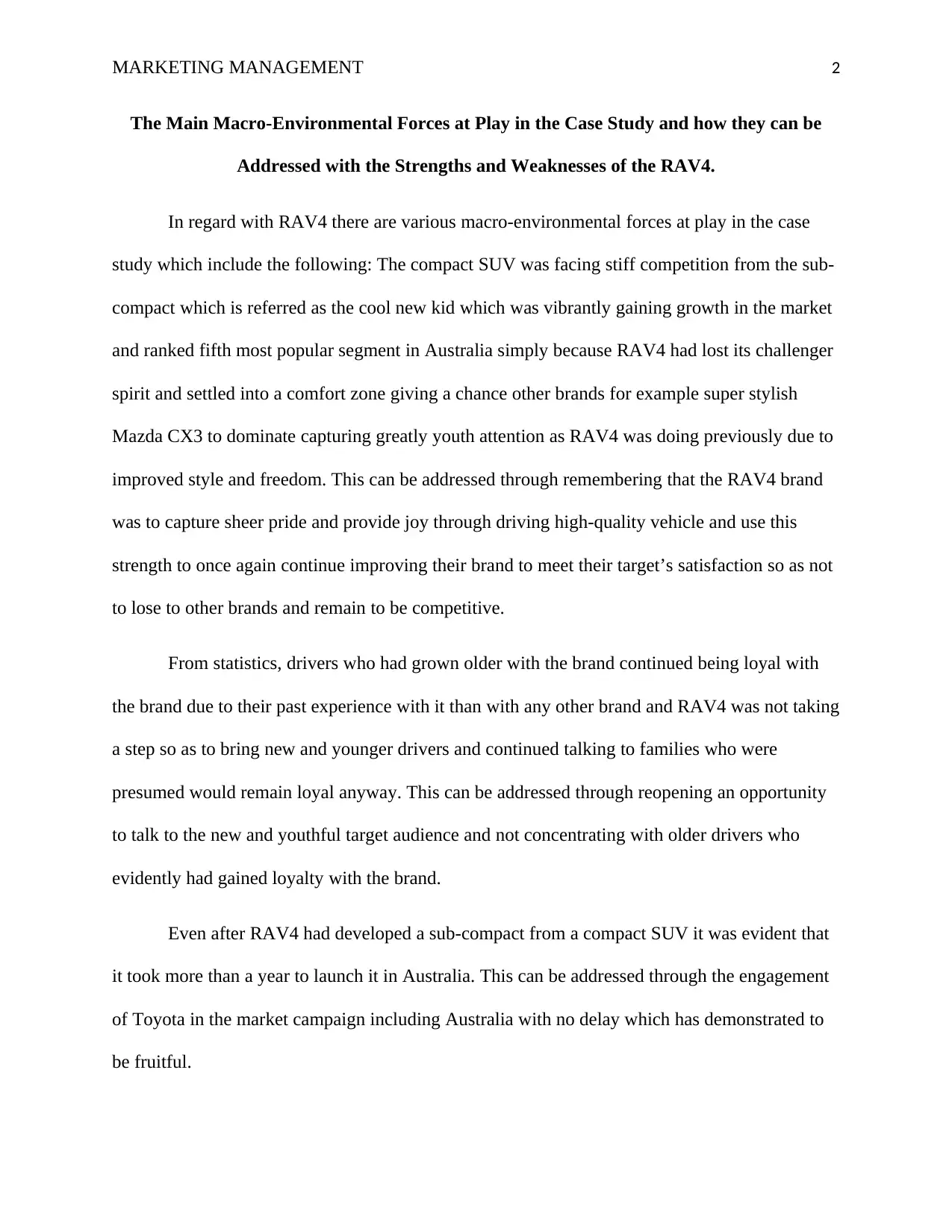
MARKETING MANAGEMENT 2
The Main Macro-Environmental Forces at Play in the Case Study and how they can be
Addressed with the Strengths and Weaknesses of the RAV4.
In regard with RAV4 there are various macro-environmental forces at play in the case
study which include the following: The compact SUV was facing stiff competition from the sub-
compact which is referred as the cool new kid which was vibrantly gaining growth in the market
and ranked fifth most popular segment in Australia simply because RAV4 had lost its challenger
spirit and settled into a comfort zone giving a chance other brands for example super stylish
Mazda CX3 to dominate capturing greatly youth attention as RAV4 was doing previously due to
improved style and freedom. This can be addressed through remembering that the RAV4 brand
was to capture sheer pride and provide joy through driving high-quality vehicle and use this
strength to once again continue improving their brand to meet their target’s satisfaction so as not
to lose to other brands and remain to be competitive.
From statistics, drivers who had grown older with the brand continued being loyal with
the brand due to their past experience with it than with any other brand and RAV4 was not taking
a step so as to bring new and younger drivers and continued talking to families who were
presumed would remain loyal anyway. This can be addressed through reopening an opportunity
to talk to the new and youthful target audience and not concentrating with older drivers who
evidently had gained loyalty with the brand.
Even after RAV4 had developed a sub-compact from a compact SUV it was evident that
it took more than a year to launch it in Australia. This can be addressed through the engagement
of Toyota in the market campaign including Australia with no delay which has demonstrated to
be fruitful.
The Main Macro-Environmental Forces at Play in the Case Study and how they can be
Addressed with the Strengths and Weaknesses of the RAV4.
In regard with RAV4 there are various macro-environmental forces at play in the case
study which include the following: The compact SUV was facing stiff competition from the sub-
compact which is referred as the cool new kid which was vibrantly gaining growth in the market
and ranked fifth most popular segment in Australia simply because RAV4 had lost its challenger
spirit and settled into a comfort zone giving a chance other brands for example super stylish
Mazda CX3 to dominate capturing greatly youth attention as RAV4 was doing previously due to
improved style and freedom. This can be addressed through remembering that the RAV4 brand
was to capture sheer pride and provide joy through driving high-quality vehicle and use this
strength to once again continue improving their brand to meet their target’s satisfaction so as not
to lose to other brands and remain to be competitive.
From statistics, drivers who had grown older with the brand continued being loyal with
the brand due to their past experience with it than with any other brand and RAV4 was not taking
a step so as to bring new and younger drivers and continued talking to families who were
presumed would remain loyal anyway. This can be addressed through reopening an opportunity
to talk to the new and youthful target audience and not concentrating with older drivers who
evidently had gained loyalty with the brand.
Even after RAV4 had developed a sub-compact from a compact SUV it was evident that
it took more than a year to launch it in Australia. This can be addressed through the engagement
of Toyota in the market campaign including Australia with no delay which has demonstrated to
be fruitful.
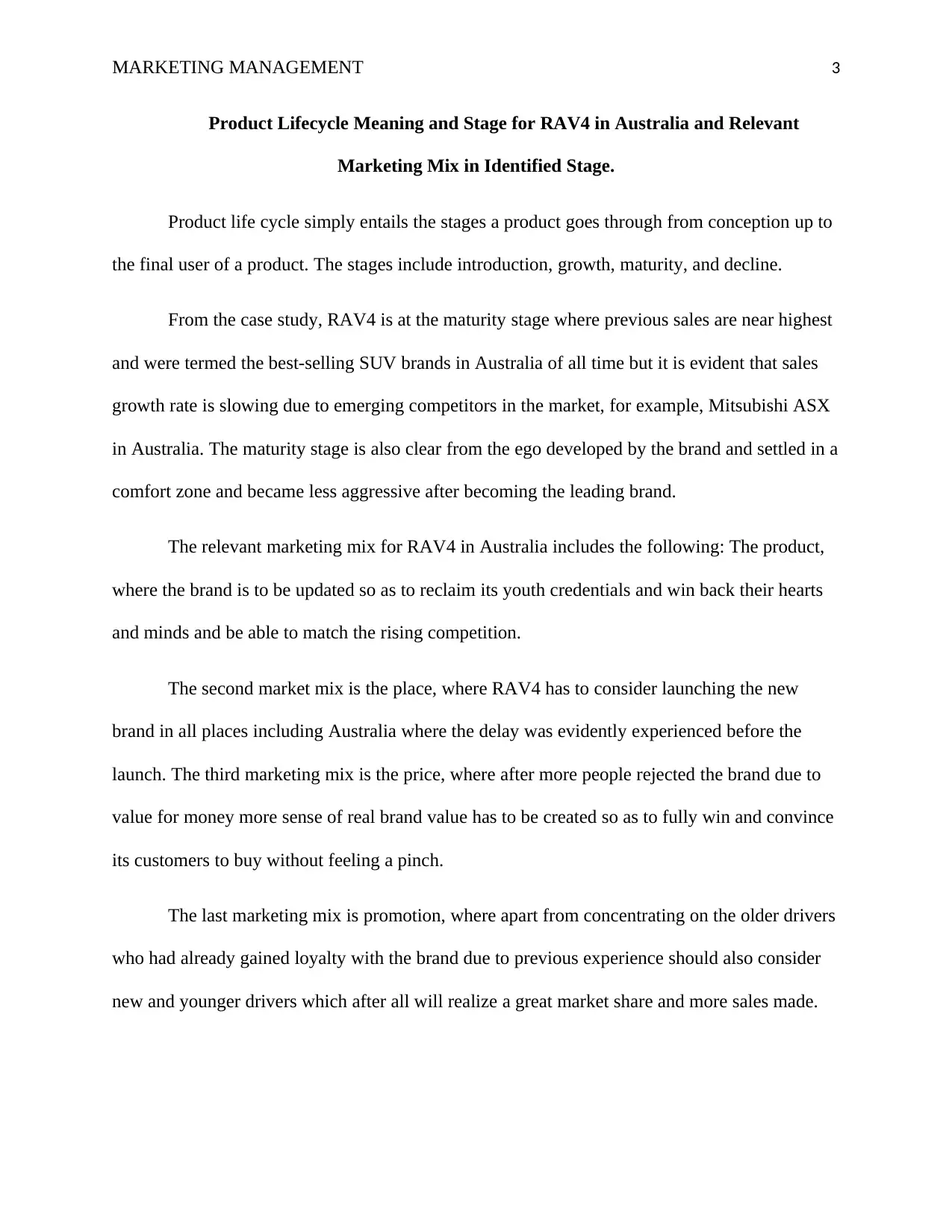
MARKETING MANAGEMENT 3
Product Lifecycle Meaning and Stage for RAV4 in Australia and Relevant
Marketing Mix in Identified Stage.
Product life cycle simply entails the stages a product goes through from conception up to
the final user of a product. The stages include introduction, growth, maturity, and decline.
From the case study, RAV4 is at the maturity stage where previous sales are near highest
and were termed the best-selling SUV brands in Australia of all time but it is evident that sales
growth rate is slowing due to emerging competitors in the market, for example, Mitsubishi ASX
in Australia. The maturity stage is also clear from the ego developed by the brand and settled in a
comfort zone and became less aggressive after becoming the leading brand.
The relevant marketing mix for RAV4 in Australia includes the following: The product,
where the brand is to be updated so as to reclaim its youth credentials and win back their hearts
and minds and be able to match the rising competition.
The second market mix is the place, where RAV4 has to consider launching the new
brand in all places including Australia where the delay was evidently experienced before the
launch. The third marketing mix is the price, where after more people rejected the brand due to
value for money more sense of real brand value has to be created so as to fully win and convince
its customers to buy without feeling a pinch.
The last marketing mix is promotion, where apart from concentrating on the older drivers
who had already gained loyalty with the brand due to previous experience should also consider
new and younger drivers which after all will realize a great market share and more sales made.
Product Lifecycle Meaning and Stage for RAV4 in Australia and Relevant
Marketing Mix in Identified Stage.
Product life cycle simply entails the stages a product goes through from conception up to
the final user of a product. The stages include introduction, growth, maturity, and decline.
From the case study, RAV4 is at the maturity stage where previous sales are near highest
and were termed the best-selling SUV brands in Australia of all time but it is evident that sales
growth rate is slowing due to emerging competitors in the market, for example, Mitsubishi ASX
in Australia. The maturity stage is also clear from the ego developed by the brand and settled in a
comfort zone and became less aggressive after becoming the leading brand.
The relevant marketing mix for RAV4 in Australia includes the following: The product,
where the brand is to be updated so as to reclaim its youth credentials and win back their hearts
and minds and be able to match the rising competition.
The second market mix is the place, where RAV4 has to consider launching the new
brand in all places including Australia where the delay was evidently experienced before the
launch. The third marketing mix is the price, where after more people rejected the brand due to
value for money more sense of real brand value has to be created so as to fully win and convince
its customers to buy without feeling a pinch.
The last marketing mix is promotion, where apart from concentrating on the older drivers
who had already gained loyalty with the brand due to previous experience should also consider
new and younger drivers which after all will realize a great market share and more sales made.
⊘ This is a preview!⊘
Do you want full access?
Subscribe today to unlock all pages.

Trusted by 1+ million students worldwide
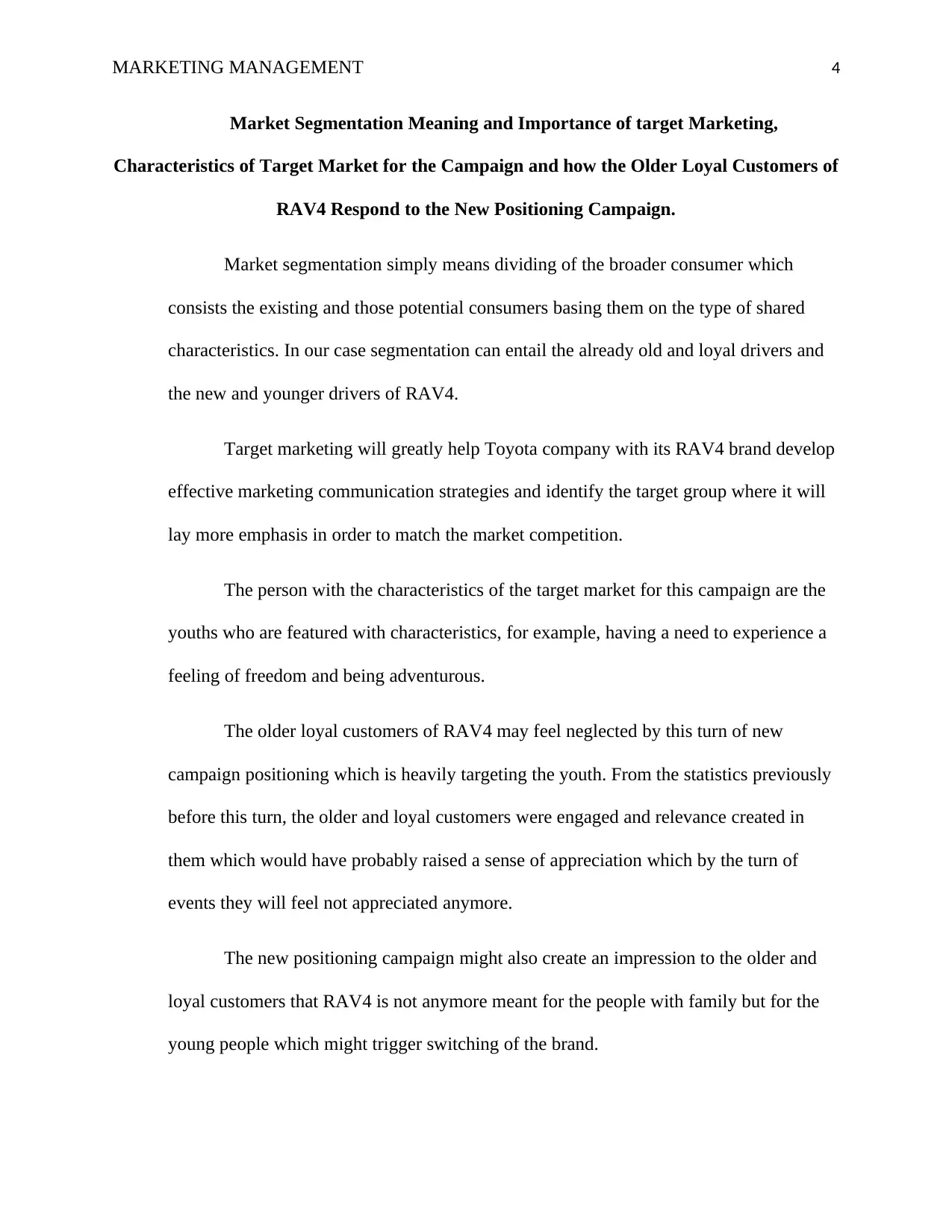
MARKETING MANAGEMENT 4
Market Segmentation Meaning and Importance of target Marketing,
Characteristics of Target Market for the Campaign and how the Older Loyal Customers of
RAV4 Respond to the New Positioning Campaign.
Market segmentation simply means dividing of the broader consumer which
consists the existing and those potential consumers basing them on the type of shared
characteristics. In our case segmentation can entail the already old and loyal drivers and
the new and younger drivers of RAV4.
Target marketing will greatly help Toyota company with its RAV4 brand develop
effective marketing communication strategies and identify the target group where it will
lay more emphasis in order to match the market competition.
The person with the characteristics of the target market for this campaign are the
youths who are featured with characteristics, for example, having a need to experience a
feeling of freedom and being adventurous.
The older loyal customers of RAV4 may feel neglected by this turn of new
campaign positioning which is heavily targeting the youth. From the statistics previously
before this turn, the older and loyal customers were engaged and relevance created in
them which would have probably raised a sense of appreciation which by the turn of
events they will feel not appreciated anymore.
The new positioning campaign might also create an impression to the older and
loyal customers that RAV4 is not anymore meant for the people with family but for the
young people which might trigger switching of the brand.
Market Segmentation Meaning and Importance of target Marketing,
Characteristics of Target Market for the Campaign and how the Older Loyal Customers of
RAV4 Respond to the New Positioning Campaign.
Market segmentation simply means dividing of the broader consumer which
consists the existing and those potential consumers basing them on the type of shared
characteristics. In our case segmentation can entail the already old and loyal drivers and
the new and younger drivers of RAV4.
Target marketing will greatly help Toyota company with its RAV4 brand develop
effective marketing communication strategies and identify the target group where it will
lay more emphasis in order to match the market competition.
The person with the characteristics of the target market for this campaign are the
youths who are featured with characteristics, for example, having a need to experience a
feeling of freedom and being adventurous.
The older loyal customers of RAV4 may feel neglected by this turn of new
campaign positioning which is heavily targeting the youth. From the statistics previously
before this turn, the older and loyal customers were engaged and relevance created in
them which would have probably raised a sense of appreciation which by the turn of
events they will feel not appreciated anymore.
The new positioning campaign might also create an impression to the older and
loyal customers that RAV4 is not anymore meant for the people with family but for the
young people which might trigger switching of the brand.
Paraphrase This Document
Need a fresh take? Get an instant paraphrase of this document with our AI Paraphraser
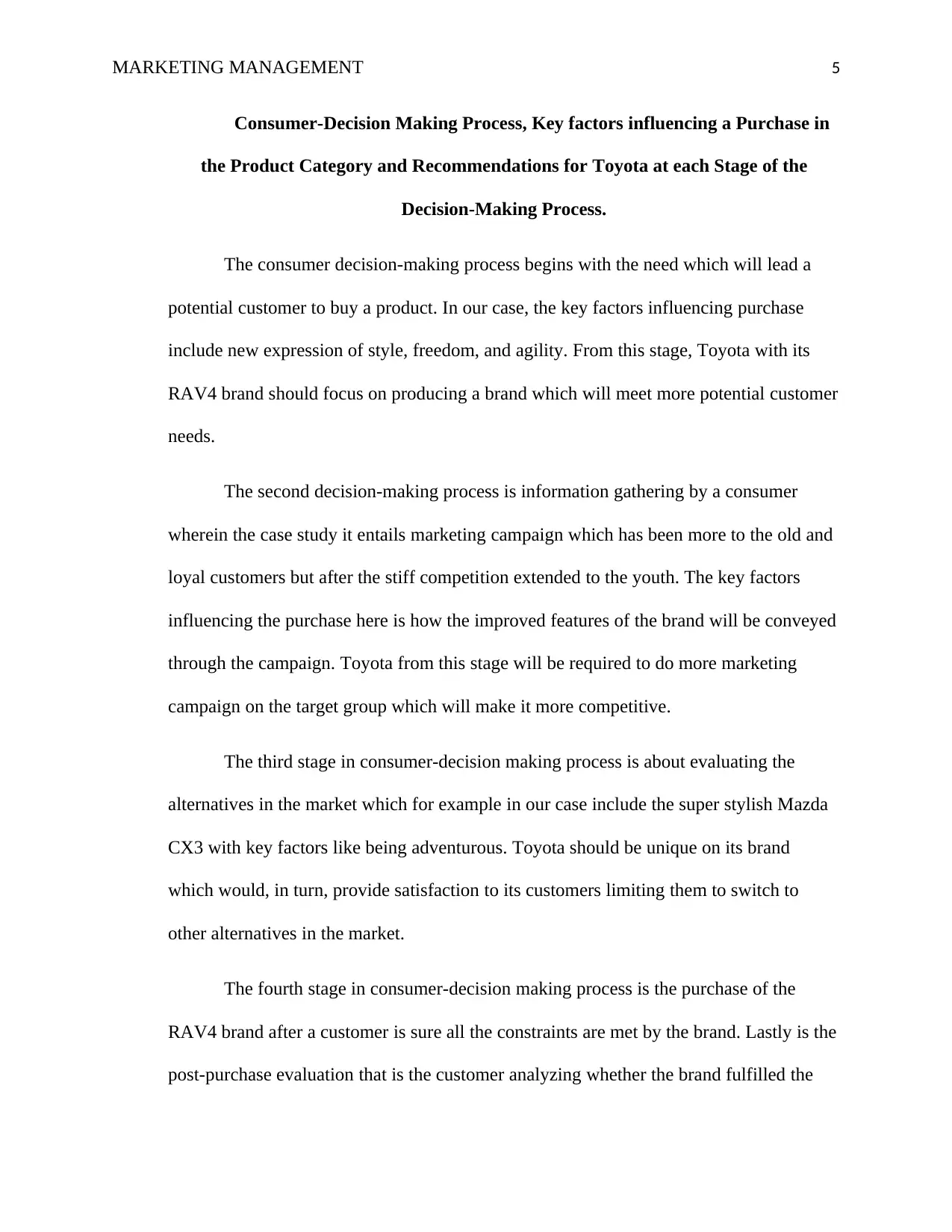
MARKETING MANAGEMENT 5
Consumer-Decision Making Process, Key factors influencing a Purchase in
the Product Category and Recommendations for Toyota at each Stage of the
Decision-Making Process.
The consumer decision-making process begins with the need which will lead a
potential customer to buy a product. In our case, the key factors influencing purchase
include new expression of style, freedom, and agility. From this stage, Toyota with its
RAV4 brand should focus on producing a brand which will meet more potential customer
needs.
The second decision-making process is information gathering by a consumer
wherein the case study it entails marketing campaign which has been more to the old and
loyal customers but after the stiff competition extended to the youth. The key factors
influencing the purchase here is how the improved features of the brand will be conveyed
through the campaign. Toyota from this stage will be required to do more marketing
campaign on the target group which will make it more competitive.
The third stage in consumer-decision making process is about evaluating the
alternatives in the market which for example in our case include the super stylish Mazda
CX3 with key factors like being adventurous. Toyota should be unique on its brand
which would, in turn, provide satisfaction to its customers limiting them to switch to
other alternatives in the market.
The fourth stage in consumer-decision making process is the purchase of the
RAV4 brand after a customer is sure all the constraints are met by the brand. Lastly is the
post-purchase evaluation that is the customer analyzing whether the brand fulfilled the
Consumer-Decision Making Process, Key factors influencing a Purchase in
the Product Category and Recommendations for Toyota at each Stage of the
Decision-Making Process.
The consumer decision-making process begins with the need which will lead a
potential customer to buy a product. In our case, the key factors influencing purchase
include new expression of style, freedom, and agility. From this stage, Toyota with its
RAV4 brand should focus on producing a brand which will meet more potential customer
needs.
The second decision-making process is information gathering by a consumer
wherein the case study it entails marketing campaign which has been more to the old and
loyal customers but after the stiff competition extended to the youth. The key factors
influencing the purchase here is how the improved features of the brand will be conveyed
through the campaign. Toyota from this stage will be required to do more marketing
campaign on the target group which will make it more competitive.
The third stage in consumer-decision making process is about evaluating the
alternatives in the market which for example in our case include the super stylish Mazda
CX3 with key factors like being adventurous. Toyota should be unique on its brand
which would, in turn, provide satisfaction to its customers limiting them to switch to
other alternatives in the market.
The fourth stage in consumer-decision making process is the purchase of the
RAV4 brand after a customer is sure all the constraints are met by the brand. Lastly is the
post-purchase evaluation that is the customer analyzing whether the brand fulfilled the

MARKETING MANAGEMENT 6
needs from factors influencing a purchase. Toyota with its RAV4 brand should make sure
all constraints entailing the customer needs are fully fulfilled to make fully customer
satisfaction.
needs from factors influencing a purchase. Toyota with its RAV4 brand should make sure
all constraints entailing the customer needs are fully fulfilled to make fully customer
satisfaction.
⊘ This is a preview!⊘
Do you want full access?
Subscribe today to unlock all pages.

Trusted by 1+ million students worldwide
1 out of 6
Your All-in-One AI-Powered Toolkit for Academic Success.
+13062052269
info@desklib.com
Available 24*7 on WhatsApp / Email
![[object Object]](/_next/static/media/star-bottom.7253800d.svg)
Unlock your academic potential
Copyright © 2020–2025 A2Z Services. All Rights Reserved. Developed and managed by ZUCOL.

